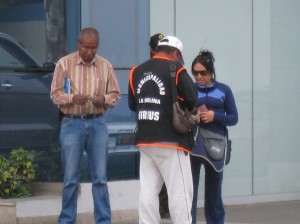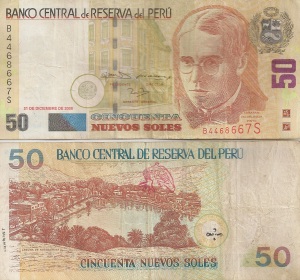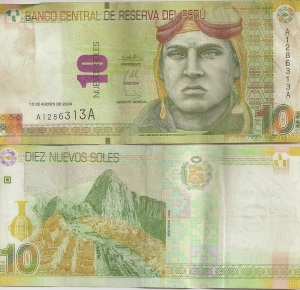Blog Archives
Vestful of Dollars
Day 012 – August 3, 2011
In my walks between our house and our local grocery store (and after taking a moment to say hello to Señor Ferrero), one of the establishments I pass by is a bank.
Loitering around this house of finance are people in photographer-style vests. However, instead of their vests being filled with lenses and other camera paraphernalia, these garments are splattered with the logo of our fine district and with dollar signs and euro signs.
These gentlemen also have the distinction of carrying with them huge wads of cash including dollars, soles, and euros.
Considering Lima’s reputation for crime, I found it odd that folks would be so open about handling large amounts of money. This is from the U.S. Department of State’s website about Peru: Violent crime, including carjacking, assault,…and armed robbery is common in Lima and other large cities.
It probably helps that banks employ security folks who patrol outside, so the monied folks hanging around these financial institutions are probably safer than the average person.
After watching for a while, I noticed that several regular people would walk up or drive up to the money people and an exchange would take place. The customer would hand over soles and receive dollars or vice-versa.
My best guess is that these vested individuals are money changers.
But, wait, don’t banks exchange money? Can’t a customer simply go into the bank with a fistful of dollars, wait in line, and exchange them for soles? Are the banks aware of this competition?
It’s just these types of observations that I love about coming to a new country. Keeps me on my toes because I may get the wrong idea…but only when it suits me.
>>>>>>>>>>
UPDATE: NOVEMBER 14, 2011
I have since learned that indeed these folks are money changers. If they have a different official term, I haven’t discovered it yet.
I have also found that these money changers offer a slightly better rate. However, there is a catch. Once again, from the State Department’s website about Peru…
Counterfeit U.S. currency is a growing and serious problem in Peru. In many areas of the city, moneychangers openly change money on the street. These individuals should be avoided as they are a conduit for counterfeit currency and in many cases, work in leagues with pickpockets by pointing out potential victims. In addition, these individuals have frequently been the victims of violent robberies in which bystanders have been injured.
Now you know. And when a man has information in his pocket, he begins to appreciate the place where he is.
Peru: Know Your Currency – Part One
Day 003 – July 25, 2011
Previous posts have talked about our adventures in the local economy. There are some stores, mainly larger grocery stores, that take the currency of the United States of America, the dollar. However, these places give your change back in the Peruvian currency, the nuevo sol, or simply sol for short.
After a few of these outings over the weekend, we had a tidy collection of soles, both paper and coin. The sol can be divided into 100 units called centimos. Peruvian coins come in the following denominations: one, five, ten, twenty, and fifty centimos.
The newness here in Peru that I find interesting is that there are sol coins also. This is akin to dollar coins in the United States, but the concept works here as opposed to the utter and dismal failure back in the States (and here and here).
The metal version of the sol comes in values of one, two, and five.
The obverse of all the coins shows the value while the reverse shows the coat of arms of Peru.
The 2 and 5 soles coin have representations of the Lines of Nazca.
(Little known fact: Thirty-six miles outside of Nazca, Peru, there are other mysterious lines carved into the desert plain. Those lines only make left-hand turns and they are called the Lines of Nascar.)
I’ll wait for you to stop groaning.
In case you were wondering why part of the title of this entry contains the text “Part One”, it’s because this post will only talk about two of the soles bills that Peru uses. This is what is known in the artistic world as “the cliffhanger” (also known as the “…to be continued” effect in the world of television).
Speaking of art (nice segue, eh?) this takes us to the subject of the subject on the fifty soles.
The bespectacled gentleman you see is Abraham Valdelomar Pinto (1888 – 1919). His Wikipedia entry describes him as…
a Peruvian narrator, poet, journalist, essayist and dramatist; he is considered the founder of the avant-garde in Peru, although more for his dandy-like public poses and his founding of the journal Colónida than for his own writing, which is lyrically posmodernista rather than aggressively experimental.
Credited with writing essays, poetry, plays, biographies, and novels, this would be like having a combination of Allen Ginsberg and Issac Asimov on the $50 note (which, truth be told, is something I would pay $50 for the U.S. Mint to do).
I found a fragment of one of Valdelomar’s poems entitled Tristita, which starts off…
Mi infancia que fue dulce, serena, triste y sola
se deslizó en la paz de una aldea lejana,
entre el manso rumor con que muere una ola
y el tañer doloroso de una vieja campana.
Since my Spanish is atrocious (see Disclaimer No. 2), I asked Google Translate for assistance and it provided the following…
My childhood was sweet, serene, sad and lonely
slipped into the peace of a remote village,
between the gentle sound that dies a wave
and the painful toll of an old bell.
The reverse of the cincuenta soles bill shows Laguna de Huacahina, an oasis in the desert near Ica, a city in southern Peru.
The 10 soles note can be seen here…
The man on the obverse is a Peruvian military aviation hero José Abelardo Quiñones Gonzáles (1914 – 1941). He is revered for his sacrifice during the 1941 war between Peru and Ecuador, when, after taking heavy damage to this plane, he crashed his aircraft into the Ecuadorian positions.
He is also credited with being the first cadet at Central Aviation College Jorge Chávez to perform an inverted loop. This explains why the older version of the ten soles bill has an upside-down plane on the reverse. At first I thought it was a misprint (similar to this famous oops), but the printers meant to do that.
The current reverse of the diez soles note shows some place or other.
As a final note on these notes, please do not print out these sample images and try to pass them off as real. Counterfeiting is sort of an issue here.


